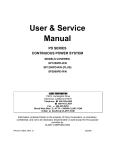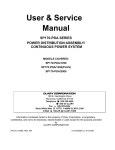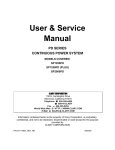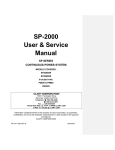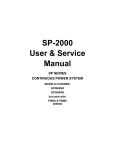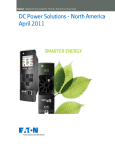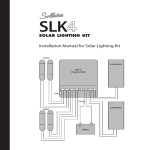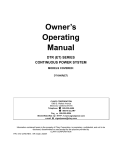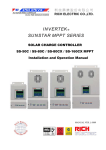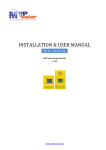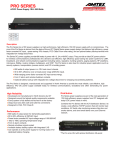Download Clary Corporation SN2000 Service manual
Transcript
User & Service Manual SP SERIES CONTINUOUS POWER SYSTEM MODELS COVERED: SP1250LX SP2000LX CLARY CORPORATION 150 E. Huntington Drive Monrovia, California 91016 Telephone 626-359-4486 800-44 CLARY Fax. 626-305-0254 World Wide Web HTTP: // WWW.CLARY.COM E-Mail SALES @ CLARY.COM Information contained herein is the property of Clary Corporation, is proprietary, confidential, and not to be disclosed, disseminated or used except for the purpose provided by CLARY CORPORATION P/N 510-16432, REV. NR 1A\PROJECT FILES\341 12/2012 THE CONTINUOUS POWER COMPANY TABLE OF CONTENTS 1 GENERAL DESCRIPTION ....................................................................................... 5 1.1 1.2 1.3 1.4 2 GENERAL CHARACTERISTICS ............................................................................ 13 2.1 2.2 3 Installation ...................................................................................................................... 18 Preparation .................................................................................................................... 18 Procedure ...................................................................................................................... 20 Operating Configuration and Setup: .............................................................................. 21 Start-up .......................................................................................................................... 22 Optional Communication Procedure .............................................................................. 23 PROGRAMMABLE LCD DISPLAY ........................................................................ 24 4.1 4.2 4.3 4.4 4.5 4.6 4.7 4.8 4.9 5 Characteristics ............................................................................................................... 13 Specifications ................................................................................................................. 15 INSTALLATION AND OPERATIONS ..................................................................... 18 3.1 3.2 3.3 3.4 3.5 3.6 4 Introduction ...................................................................................................................... 5 Operating Modes ............................................................................................................. 6 Physical Description......................................................................................................... 7 Summary Of Connectors – Bypass Box ........................................................................ 11 Introduction .................................................................................................................... 24 Normal Mode ................................................................................................................. 25 Battery System Status ................................................................................................... 25 Power System Status .................................................................................................... 27 UPS System Status ....................................................................................................... 28 UPS Information............................................................................................................. 29 Time and Date ............................................................................................................... 30 Miscellaneous Item’s...................................................................................................... 31 Relays ............................................................................................................................ 32 CARE AND MAINTENANCE .................................................................................. 37 5.1 5.2 5.3 5.4 Safety ............................................................................................................................. 37 Preventive Maintenance ................................................................................................ 38 Trouble Analysis ............................................................................................................ 39 Service and Repair ........................................................................................................ 40 WARRANTY ................................................................................................................. 41 2 THE CONTINUOUS POWER COMPANY LIST OF FIGURES Figure 1: FRONT PANEL VIEW SP1250LX-N SHOWN ................................................. 8 Figure 2: BYPASS BOX ...................................................................................................... 11 Figure 3: BYPASS BOX with GFCI Option ...................................................................... 12 Figure 4: UPS TO CABINET INTERCONNECTIONS.................................................... 21 LIST OF TABLES Table 1: FIGURE 1 DESCRIPTIONS ................................................................................ 9 Table 2: BYPASS BOX DESCRIPTIONS ........................................................................ 11 Table 3: BYPASS BOX DESCRIPTIONS ........................................................................ 12 Table 4: ELECTRICAL SPECIFICATIONS ...................................................................... 15 Table 5: Physical Specifications, UPS Electronics Module ........................................... 16 Table 6: PHYSICAL SPECIFICATIONS ........................................................................... 16 Table 7: ENVIRONMENTAL SPECIFICATIONS ............................................................ 16 Table 8: BATTERY SPECIFICATIONS ............................................................................ 16 Table 9: CLARY OutPostTM BATTERIES* ....................................................................... 17 Table 10: RECOMMENDED INSTALLATION EQUIPMENT ........................................ 19 Table 11: TYPICAL INSTALLATION PROCEDURE FOR TRAFFIC UPS ................. 20 Table 12: LIST OF RULES ................................................................................................. 35 Table 13: ALARMS AND FAULTS .................................................................................... 36 Table 14: DEFAULT SETTINGS ....................................................................................... 36 Table 15: PREVENTIVE MAINTENANCE SCHEDULE ............................................... 39 3 “IMPORTANT SAFETY INSTRUCTIONS” “SAVE THESE INSTRUCTIONS” This manual contains important safety instructions that should be followed during installation and maintenance of the UPS and batteries. The instructions should be followed during installation and maintenance of the UPS and batteries. Be aware of the following symbols and their meaning as they appear throughout the manual: This symbol indicates that dangerous voltage constituting a risk of electrical shock is present within the unit. ! This symbol indicates that there are important operating and maintenance instructions in the literature accompanying this unit. CAUTION RISK OF ELECTRIC SHOCK DO NOT OPEN ! Earth Ground Symbol: On / Off Symbol: Maximum Ambient Temperature 74°° C. This unit intended for installation in a controlled environment (temperature controlled, indoor area free of conductive contaminants). CAUTION – Do not dispose of batteries in a fire. The batteries may explode. CAUTION - Do not open or mutilate the batteries. Released electrolyte is harmful to the skin and eyes. It may be toxic. CAUTION - A battery can present a risk of electrical shock and high short circuit current. The following precautions should be observed when working on batteries. 1. Remove watches, rings, or other metal objects. 2. Use tools with insulated handles. 4 1 GENERAL DESCRIPTION 1.1 Introduction You have selected the highest quality power protection system available for your traffic control devices. You now own a SP-LX Series Traffic UPS (Uninterruptible Power System) with a programmable LCD display. The SP-LX Series is an all Digital Technology UPS product designed and manufactured by Clary Corporation, the first name in UPS reliability. Clary UPS can be found on naval warships and submarines, hospital operating rooms, labs, water treatment plants and traffic intersections. The SP-LX Series offers a rugged, compact package with superior features and performance you can depend on. When power problems occur, there can be no compromising the operations and reliability of your traffic control devices - - and no compromising public safety. With fully conditioned, regenerative, sine wave power and military-quality battery backup, the SP-LX Series Traffic UPS is your complete power solution. This Owner’s Operating Manual is provided with your new SP-LX Series Traffic UPS. It will enhance your understanding of the product and its functions. WE STRONGLY URGE YOU TO READ THIS MANUAL COMPLETELY, PRIOR TO BEGINNING INSTALLATION OR ATTEMPTING OPERATION. Studying this manual will save you time and effort in your installation and application, and it will assure a trouble free installation and startup session, thus enhancing public safety and the image of your agency. The illustrations provided will familiarize you with this product’s operating modes and components. Always operate the unit within the guidelines and specifications provided to maximize safety and the lifetime of the unit. Your understanding of the product is a key element in assuring the proper use and effectiveness of the SP-LX Series Traffic UPS. 5 1.2 Operating Modes Clary’s SP-LX Series Uninterruptible Power Systems (UPS) are designed for powering low power (i.e., LED & NEON) traffic & pedestrian indications, plus critical traffic control devices (i.e., controllers, modems, CMU’s, etc.). The power system consists of three elements, which work together to provide critical loads with continuous, conditioned, regulated, sinusoidal waveform power that is free from disturbances such as spikes, surges, brownouts or blackouts. These elements are the: 1. UPS Module – (UPS) 2. Bypass Box 3. Battery Module Backup power is achieved with a set of rechargeable, SVRLA (sealed valve-regulated lead-acid), maintenance-free, AGM (absorbed glass mat), batteries. The complete UPS system is controlled by an onboard digital microprocessor at all times. The UPS continuously generates 120V AC power to the equipment. SP1250LX The SP1250LX has an extended load option that will allow 1400 Watts peak load for ten seconds. This option allows for support of intersections that have not yet replaced the yellow incandescent traffic lamps. Additional Notes on Operating Modes: • The SP-LX Series Traffic UPS is designed for compatibility with, and complete transparency to, all traffic signal cabinet functions including police panel operation. RELAY CONTACTS: The UPS includes eight (8) sets of normally-open (NO) and normally-closed (NC) relay style contacts. The contacts are intended to connect to the Flash controllers or other devices in the traffic cabinet. The contacts are actuated at various times as a means of signaling these devices of important aspects of current operation. These relays can be programmed from the Front Panel LCD Display. You can set any of the relays to a certain condition listed in Table 12. See section 4.10 for programming instructions. 6 1.3 Physical Description This section will point out and illustrate the various indicators, functions and controls of the SP-LX Series UPS. The important attributes of the SP-LX Series unit are numbered to assist you in locating them on your machine and also to fully explain its function and how it relates to system operation. Numbers on the drawing will correspond to the operating component’s name at the bottom with a brief identification. In the next section, a complete explanation of all numbered items will be enhanced to ensure you have a full understanding of the operation of this system. Visual indicators used on the front panel are long lasting, very efficient, light emitting diodes (LED). When operating the push-button switches, always hold the switch in for at least two seconds to insure function confirmation. This feature has been implemented into the system design to avoid inadvertent operation of any of the user-available functions. Figure 1 is the front view of the model SP1250LX. 7 Table 1 describes items 1 – 23. N C C N O N C C N O N C C N O N C C N O Figure 1: FRONT PANEL VIEW SP1250LX-N SHOWN 8 Table 1: FIGURE 1 DESCRIPTIONS PANEL VIEW DESCRIPTIONS 1 SYSTEM POWER SWITCH 13 DC IN – Input receptacle for all DC power (to Batteries) 2 INPUT AC LINE BREAKER 14 AC IN / OUT – Input terminal block for all AC power to Bypass Box 3 LCD DISPLAY 15 RELAYS – NO/NC Contacts for Flash 4 SELECT/MENU MODE 16 BATTERY TEST POINTS 5 ENTER/SHOW TIME 17 AUX. TEMP. SENSOR – Input for Optional Aux. Temp. Sensor 6 UP ARROW + 18 RS232 – Computer communications signals 7 DOWN ARROW - 19 USB – Computer communications 8 COLD START – DC start switch 20 CIRCUIT BREAKER – Protection for output receptacles 9 COLD START INDICATOR 21 OUTPUT RECEPTACLE – Continuous power receptacles 10 ALARM SILENT/TEST – Dual function switch 22 PROGRAMMING BUTTON 11 ALARM SILENT/TEST ACKNOWLEDGE INDICATOR 23 SNMP - OPTIONAL 12 DC INPUT – Protection circuit breaker for battery 9 SUMMARY OF INDICATORS AND CONTROLS SYSTEM POWER SWITCH - The main control switch that engages utility power to the entire unit. By activating this switch it initializes normal operation. DC INPUT - A single pole, 20A (30A for SP2000LX) circuit breaker used to connect the battery to the internal UPS electronics. It also protects against over-current situations in the battery circuit. INPUT AC LINE BREAKER - The input line protection device to limit excessive current draw to the system on over-loads. Rated 20A/250V (30A/250V for SP2000LX) COLD START - A momentary push-button switch to activate the system in the event no utility power is available. The system will be allowed to start up by using power from the battery. Depress this switch, the indicator above it will light, and hold it in until the audible alarm beeps once. The system will maintain a load for a period of time depending upon the condition of the battery. DC INPUT breaker must be ON. ALARM - This is a fault indicator that will light in the event that the inverter generator is nonoperable. This could be due to an over-temperature situation or an inverter malfunction. ! NOTE - Cold Start and Alarm Silent switches must be held in for at least two seconds to engage their function. This is to prevent any inadvertent switch operation. RS232 - A DB-9 subminiature, female connector that outputs true RS232 communications signals. UPS OUTPUT – An IEC C13 Outlet connector that provides continuous power. This receptacle is connected to the bypass line when the inverter is not running. UPS OUTPUT CIRCUIT BREAKER - A 15A protective circuit breaker. Protects the UPS OUTPUT IEC C13 connector noted above. USB - A USB Type B connector for computer communications. AC IN/OUT - A six-position connector provided for AC power to and from the UPS to the Bypass Box. DC INPUT - A two-position connector provided for battery power to the UPS. RELAYS – Eight sets of normally open (NO) and normally closed (NC) contacts. These contacts are programmable thru the LCD display. See section 4.10 for instructions. LCD DISPLAY & PUSH BUTTONS – An LCD Display showing UPS system data, status and settings. See section 4. 10 1.4 Summary Of Connectors – Bypass Box Figure 2: BYPASS BOX 9 1 2 4 3 1 – To Utility - H 2 – To Utility - N 3 – To UPS IN - H 4 – To UPS IN - N 5 – To UPS OUT - H 5 6 7 8 6 – To UPS OUT - N 7 – To CABINET - H 8 – To CABINET - N 9 - Generator Input (Optional) Table 2: BYPASS BOX DESCRIPTIONS 11 Figure 3: BYPASS BOX with GFCI Option 11 10 1 2 1 – To Utility - H 2 – To Utility - N 3 – To UPS IN - H 4 – To UPS IN - N 5 – To UPS OUT - H 6 – To UPS OUT - N 3 4 5 6 7 8 7 – To CABINET - H 8 – To CABINET - N 9 - Generator Input (Optional) 10 - GFCI Outlet (Optional) 11 - Circuit Breaker for GFCI Table 3: BYPASS BOX DESCRIPTIONS 12 9 2 GENERAL CHARACTERISTICS 2.1 Characteristics Overview The Clary SP-LX Series Traffic UPS is a turnkey, true on-line, power conditioner and battery backup or uninterruptible power system (UPS) designed for the extreme environments found in traffic cabinets (-40 to + 74 deg C). The Clary SP-LX Series, with its standard 41Ahr battery pack, is capable of operating, a full LED intersection for over 2 hours at 700W (watts) output. A typical intersection consuming 450W can be powered for approximately 4 hours. In Red-Flash operation, which consumes only about 300W, over 6 hours of backup is possible. These times assume fully charged batteries at the ambient temperature of 25C. Operation The Traffic UPS is capable of producing a full regenerated and regulated, true sine wave power, with continuous AC outputs. The Bypass Box is the link between the utility power, the UPS power, and the loads. The Bypass Box enables removal and replacement of the Traffic UPS without shutting down the traffic control system (i.e. “hot swap” capability). For 170 type cabinets, upon loss of power the Traffic UPS can actuate the existing Flash Transfer Relays (FTRs), Mercury Contactor (MC) or Railroad Preemption to allow the traffic control system to put the cabinet into Flash Mode operation. Existing Flasher Modules and Flash Transfer Relays are utilized. The Traffic UPS does not duplicate or take over flash operation or flash transfer relay functions. The Traffic UPS provides continuous, fully regenerated, conditioned, regulated, sinusoidal (AC) power to selected devices such as signal controllers, counters, modems, communications hubs, NTCIP adapters, video equipment, etc. To facilitate emergency crews and police activities, the Traffic UPS is compatible with police panel functions (i.e. “Signals OFF” switch must kill power to the field wiring even when on UPS/Battery power). Utility Voltage Windows and Battery Operation The UPS operates on utility power if the utility voltage is between 75 and 155 VAC. When the utility falls below 75 VAC or climbs above 155 VAC the UPS operates from the batteries. 13 Description The Traffic UPS consists of three major components, the UPS Power Module, the Bypass Box, and the Battery System. The UPS Power Module consists of the following: • True on line, double conversion, pure sine wave, high frequency inverter utilizing IGBT technology. • Programmable LCD Display. • A DB9 RS232 and USB Type B connectors for remote signal alarms and true RS232 monitoring and remote communications. • Auxiliary Temp Sensor • Multi-stage, temperature compensated battery charger. The Bypass Box. A three-pole, double-throw switch that switches both hot and neutral lines to the UPS or cabinet. The Battery Module. The battery is comprised of one or more strings of 6 or 8 individual 12V batteries connected in series for a total string voltage of 72VDC nominal or 96VDC for SP2000LX. The batteries are extreme temperature, deep cycle, AGM/VRLA (Absorbed Glass Mat/ Valve Regulated Lead Acid) batteries that have been field proven and tested by the U.S. military. The OutPostTM batteries supplied by Clary Corporation are certified to operate at extreme temperatures from –40°C to +74°C. The batteries are provided with appropriate interconnect wiring harness. Optional battery mounting trays and brackets are available. The interconnect cable connects to the base module via a quick-release circular connector. The UPS module includes a charger that replenishes the Battery Pack whenever possible and required. This charger operates with a charging current of 0.6A. An Optional Fast Charger operates with a charging current of up to 3.5A. Mounting/ Configuration NEMA Style: mounting method is shelf-mount or wall-mount.170 Style: Mounting method is 19” rack-mount. Shelf angles or rails, typically supplied by others, are available as optional accessories. Battery construction includes heavy-duty, inter-cell connections for low-impedance between cells, and heavy-duty plates to withstand shock and vibration. 14 2.2 Specifications The various specifications of the UPS system are provided in the following tables. Table 4: ELECTRICAL SPECIFICATIONS Electrical Specifications Input Specification Nominal Input Voltage 120 VAC, Single Phase Input Voltage Range 75 VAC to 155 VAC Input Frequency 45 to 65 Hz (+/- 5%) Input Configuration 3 Wire (Hot, Neutral & Ground) Input Protection Input breaker 20 amps, SP2000LX 30A Output Specification Nominal Output Voltage 120 VAC, Single Phase Power Rating 1.25 KVA (1250VA/875W), 2 KVA (2000VA/1400W) Output Voltage Regulation +/- 4% for 100% step load change and from High battery to Low battery condition Output Frequency 50 or 60 Hz (+/- .5%) unit not in sync. Output Configuration 3 Wire (Hot, Neutral & Ground) Output Wave Form True Sine wave Overload capability 110% for 10 minutes 200% for 50 milliseconds 2k PLUS 160% for 10 seconds Fault clearing Current limit and automatic shutdown Short circuit protection Current limit and automatic shutdown Efficiency 85% at full load (on utility) Load Power Factor .7 lagging through unity to .7 leading 15 Table 5: Physical Specifications, UPS Electronics Module Physical Specifications, UPS Electronics Module Dimensions: Width = 19”, Depth = 10”, Height = 3.5” Weight: UPS: 27 lbs., Shipping weight: 33 lbs. Table 6: PHYSICAL SPECIFICATIONS Physical Specifications, Bypass Box Dimensions: Width = 7”, Depth =2.5”, Height =4.5” Weight: BYPASS BOX: 5 lbs., Shipping weight: 5 lbs. Table 7: ENVIRONMENTAL SPECIFICATIONS Environmental Specifications Temperature: - 40°C to +74°C. Table 8: BATTERY SPECIFICATIONS Battery Specifications Temperature: – 40°C to +74°C. Ampere-Hour ratings: see Table 9 Hydrogen gas emissions: meets Mil-Spec #MIL-B-8565J 16 Table 9: CLARY OutPostTM BATTERIES* Estimated Runtime (Per set @ 77°F / 25°C) (New Batteries, fully charged) Clary Volts/ Part. No.* A-hrs. OP72C (Set of 6 Batteries) 12 VDC/ 300 Watts 6.3 500 700 875 Watts Watts Watts 3.8 2.5 1.8 Hrs.** Hrs.** Hrs.** Hrs.** Unit Weight Overall Dimensions Per Battery Inches (cm.) Lbs. Length Width Height (Kg.) L W H 29 7.68 5.15 7.9 (13.2) (19.6) (13.1) (20.1) 41 AH Clary Part. No.* Volts/ A-hrs. 300 Watts 700 1050 1400 Watts Watts Watts OP96C (Set of 8 Batteries) 12 VDC/ 41 AH 8.5 3.5 1.5 1.0 Hrs.** Hrs.** Hrs.** Hrs.** *OP72C battery sets include six (6) batteries per set. Wired in series, each set provides 72 VDC. *OP96C battery sets include eight (8) batteries per set. Wired in series, each set provides 96 VDC. ** Actual times may vary, runtimes are dependent on many factors. Lower/Higher AH capacity batteries, allowing less or more runtime, are available on special order. Contact factory for more information. Communications, Controls & Diagnostics Optional TCIP/Ethernet available, contact factory for more information. Front Panel controls: Power ON, Cold (DC) Start, Alarm Silence, Battery Test, Bypass Circuit Breaker, and DC/Battery Circuit Breaker. Options Battery Tray to hold three (3) OP72C batteries is 19” wide for use in 170 type cabinets and mounts on standard RETMA rails. Swing-out Battery Box, mounts on right rail inside back door of 170 type cabinets. Box is designed to hold tree (3) OP72C batteries External Temperature Sensor (SPD-16H1) 17 3 INSTALLATION AND OPERATIONS 3.1 Installation The UPS system is typically rack or shelf mounted in standard traffic cabinets. When determining how to position the UPS system inside your cabinet, the following requirements MUST be met. • The installation site MUST maintain an ambient air temperature of less than 165oF (74oC). • The air inlets, vents and fan MUST NOT be obstructed or blocked in any way. There MUST BE clearance around each air-inlet and vent. • The air should remain free from excessive dust and chemical fumes. • Total power requirements to be drawn from the UPS must not exceed the rated power of the UPS. Please note these items when designing the UPS system’s mounting hardware: • 3.2 The front panel is designed to fit in a standard 19" rack. This panel fills a 3.5 inch slot. Preparation Installation of the SP-LX Series Traffic UPS must be preceded by careful preparation. The following steps are typical: • Ensure that the Installation Requirements will be met. (See previous section). • Read this manual thoroughly. • Assemble wiring diagrams. 18 • • • • • Unpack and ensure that all UPS System components are on-hand and operative: o UPS System Module o (Bypass Box) o Battery Module (6 or 8 batteries w/cabling) Collect appropriate mounting hardware for the particular installation. o For 170/332 cabinets only, one or two battery trays (per shipping documents, depends on version purchased) Assemble your tools and inventory your equipment. Table 10 is a checklist of items that have proved useful during previous installations. Contact the responsible agencies to schedule a brief power down (10 to 15 minutes) at the intersection(s) affected. Allot 2 hours of time for the installation. Table 10: RECOMMENDED INSTALLATION EQUIPMENT Armored sheathing (cable protector) Connectors (butt type and insulated) Cordless drill w/ bits and a spare Crimpers (for insulated and nonbattery pack insulated connectors) Dikes DVM w/ probes Electrical Tape Flat Head screwdriver Hardware in spill-proof carrying case Hold-downs (adhesive back) Nut Driver Set #2 Phillips head screwdriver Phillips head drill bit Propane torch (miniature) or cigarette lighter Shrink tubing Socket Set Socket Wrench Current clamp meter Wire cutters Wire strippers 19 3.3 Procedure The recommended installation procedure is presented in Table 11 . The Table refers to, which presents a schematic wiring diagram. Read through the entire procedure before beginning. If any steps are unclear, do not begin the installation process – please contact Clary Corporation for assistance. Finish each step completely before continuing to the next. See Figure 4 for diagram. Table 11: TYPICAL INSTALLATION PROCEDURE FOR TRAFFIC UPS 1. Mount Bypass Box and position switch to Bypass. 2. Disconnect utility input H from input terminal block in cabinet and connect to Bypass Box (To Utility H). 3. Disconnect utility input N from input terminal block in cabinet and connect to Bypass Box (To Utility N). 4. Connect AWG #10 black wire from Bypass Box (To Cabinet H) to input terminal block (H) in the cabinet. 5. Connect AWG #10 white wire from Bypass Box (To Cabinet N) to input terminal block (N) in the cabinet. 6. Connect the AWG #10 green wire from the provided cable assembly to the ground bus terminal in the cabinet. 7. Mount UPS in cabinet and make sure system switch is in the “OFF” position. 8. Mount Batteries and connect all interconnect connectors from the battery cable. 9. Connect Cable from the Bypass Box to the UPS. 10. Connect battery cable to UPS. Make sure the six or eight batteries are wired in series (+ to -) with 72VDC or 96VDC full potential across complete string. 11. Connect Flash connections to the UPS. 12. Verify proper programming of relay contacts. 13. Test installation for proper operation. 14. Document installation. 20 3.4 Operating Configuration and Setup: Figure 3 shows how the UPS System is connected to the traffic cabinet. This schematic diagram illustrates the interconnections. N C O N C N C O N C N O C N C Figure 4: UPS TO CABINET INTERCONNECTIONS 21 N O C N C 3.5 Start-up Once the system has been properly installed, it is ready to operate. The following procedures will explain how to start-up the system while wired into rated electrical power and also how to start-up with no AC power available. Note: When Powering up for the first time or if unit has not been powered up for more than 10 days, the LCD Display should be initialized. Please see page 28 ST45 for instructions. Normal Operation on AC Start-Up: • Verify that the unit is wired into properly rated electrical power through the Bypass Box. • The AC IN and DC IN cables must be fully connected to the unit. Position the DC breaker to the ON position. • Position the System Power Switch to the ON position. After switching ON, the UPS performs a self-test and the display will show: SP1250LX mm/dd/yy hh:mm:ss www.clary.com After completion of the self-test, the display will show the default screen (values are examples). SP1250LX ONLINE VAC: 120.0V, 60.0Hz LOAD:50% BAT:80% AC LINE OK, INV ON • Battery Operation after AC Start-Up: When Utility power is lost, the Alarm LED will blink and the display will show: (values are examples) SP1250LX ONLINE VAC: 000.0V, 00.0Hz LOAD:50% BAT:80% AC LINE BAD, INV ON Once power has returned, the cabinet operation will continue to operate without interruption. If the unit is allowed to operate until batteries are exhausted, the unit will time out and shut off completely. If power were to return, the unit will automatically restart. DC Start Operation (Cold Start) If no utility power is available at the time backup power is required, the unit may be started to accomplish abbreviated tasks. The limitations of the battery prevent extended operations at full load. • Position the DC Input Breaker to the ON position. • Position the System Power Switch to the ON position. • Push and hold in the COLD START switch until the audible alarm beeps. The unit will start up similarly to normal AC start-up except the Alarm LED will continue to blink. It will now operate as described above in battery operation. 22 3.6 Optional Communication Procedure The UPS system includes additional interfaces for communications to host computers or other similar devices. Their use is optional, but allows for remote monitoring and control of the power system. Effective utilization of these capabilities will enhance the reliability of the traffic power system. There is one DB-9, subminiature, female connector and one USB type B connector. These connectors are provided for communications links to a computer or sophisticated monitoring device. Use the USB Type B connector when using the Clary Universal Traffic software which can be downloaded at www.Clary.com. See Below for Pin assignments. DB9F CONNECTOR 1- GP_OUT_1 (GENERAL PURPOSE OUTPUT 1) 2- RECEIVING DATA (RXD) (9600 Baud) 3- TRANSMITING DATA (TXD) (9600 Baud) 4- GP_OUT_2 (GENERAL PURPOSE OUTPUT 2) 5- SIGNAL GROUND 6- DATA SET READY (DSR) 7- REQUEST TO SEND (RTS) 8- UTILITY FAIL 9- LOW BATTERY USB TYPE B CONNECTOR 1- VBUS 2- D- (DATA-) 3- D+ (DATA+) 4- GND 23 4 PROGRAMMABLE LCD DISPLAY 4.1 Introduction The LCD display on the UPS front panel is used to show various operational parameters of the UPS (in real time) as well as other important system information. It is also used to program options and set points for many UPS functions. The LCD display operates in two main modes: 1. Normal Mode - The default mode of operation for displaying real time UPS parameters. When left unattended, the display will always revert back to normal mode. 2. Menu Mode - Used for accessing additional system information and for programming any modifiable UPS parameters. Menu mode is accessed by pressing and holding the Select/Menu Mode button for approximately two seconds. The Programmable LCD Display is operated by the 4 push button switches. Once in Menu mode, the following seven main menus can be selected: 1. Battery system 2. Power system 3. UPS system 4. UPS info 5. Time/Date 6. Relays 7. Miscellaneous Items From the normal mode’s main screen, depress and hold the SELECT/MENU MODE button until Menu mode is entered (You will hear three quick beeps and LED’s will be blinking Red and Green). Press the SELECT/MENU MODE button to go to the menu you want then press ENTER. You will now be in one of the seven menus. 24 4.2 Normal Mode The Normal mode’s main screen shows the Load and Battery percentage, AC input status and Inverter status. The Normal mode display will look something like the following. SP1250LX ONLINE VAC: 120.0, 60.0Hz LOAD:100% BAT:95% AC LINE OK, INV ON To see the time and date, press the ENTER/SHOW TIME button. SP1250LX mm/dd/yy ONLINE hh:mm:ss 4.3 Battery System Status STATUS: BATTERY Syst Once at this screen, press the ENTER/SHOW TIME button. Then press the SELECT/MENU MODE button to go through the Battery System Status menu. St20: Battery Status 078V => BAT is FULL Shows Battery status and Voltage St21: Bat Condition Battery is GOOD! Shows condition of the Batteries. St22: Battery Usage 15 HOUR 10 MIN Shows total time in hrs that UPS was running off of Battery Power. To Clear usage, press and hold both the UP and Down Arrow buttons simultaneously until the time clears. 25 St23: BACKUP Events 2 Events Shows number of times UPS went to Battery Power. To clear events, press and hold both the UP and Down Arrow buttons simultaneously until the event count clears. St24: Battery Type 72 Volts 41 Ahr Shows the nominal battery voltage and the battery Amp hours. St25: Battery Ahr ALTER> Ahr = 41 This screen allows the user to enter the Battery Capacity within the range of 10Ahr to 150Ahr. To change Ahr rating, Press Enter. Press the Arrow buttons until the desired rating is displayed. Press Enter to keep this change. St26: Batt Inst Date mm/dd/yyyy Shows Battery installation date. Can only be set to the current date. To reset, press and hold both the UP and Down Arrow buttons simultaneously until it resets to the current date. 26 4.4 Power System Status STATUS: POWER System Once at this screen, press the ENTER/SHOW TIME button. Then press the SELECT/MENU MODE button to go through the Battery System Status menu. St30: Input Line Pwr 115Vrms 60Hz 1.5A Shows the Input line power Voltage, Frequency and Current going into the UPS. St31: Power Source UTILITY Shows the power source which the UPS is currently running off of (UTILITY or BATTERY). St32: Output Pwr/Ld 120Vrms 60Hz 50% Shows the Output Voltage, Frequency and Load percentage. 27 4.5 UPS System Status STATUS: UPS SYSTEM Once at this screen, press the ENTER/SHOW TIME button. Then press the SELECT/MENU MODE button to go through the Battery System Status menu. St40: Operating Mode NORMAL Shows the operating status of the UPS (NORMAL, BACKUP,……..etc). St41: Alarm Status 1 ALARM Shows the Alarm status and number of alarms which are currently active (OVERTEMP, OVERLOAD, OUTPUT BAD, INPUT IS BAD………...etc). St42: Temperature Loc 25C Rem 25C NORMAL Shows the local and remote temperature in degrees Celsius. Remote temperature readings are available only when an auxiliary temperature sensor is installed. St43: POWERDOWN Stat f_code: 00 BATDEAD NORMAL Shows the reason the UPS shutdown previously with an associated error code. St44: INITIALIZE ALL PARAMS but TIME/DATE NORMAL Press and hold both arrow buttons to initialize. This will set all settings except for the date and time back to the factory default. St45: INITIALIZE ALL LCD PANEL PARAMETERS NORMAL Press and hold both arrow buttons to initialize. This will set all settings to the default. 28 4.6 UPS Information Status: UPS Info NORMAL Once at this screen, press the ENTER/SHOW TIME button. Then press the SELECT/MENU MODE button to go through the UPS Information menu. St50: UPS Base Model # SP1250I Shows UPS Base Model# St51: UPS User Model My Model # NORMAL Shows the model of the UPS. To change the model #, Press the enter key. Hold down the Enter, Up Arrow and Down Arrow until display clears. Use the arrow keys to increment to the character you want. Press Enter to go to the next position. St52: UPS Pwr Rating 1250VA Shows UPS power rating in VA. St53: DSP Firmware UPS Control Brd Code Version: <DSP 1.14> Dev date SEP 06, 2012 Shows the type and revision of the UPS firmware(EPROM) installed in the unit. St54: ARM St53: LCD Firmware Firmware DEV Front UPS 04-08-2004 Panel Code REV-B Version: <ARM 1.04> Dev date: 10-02-2012 Shows the type and revision of the firmware installed in the LCD Display. Screen shown is just an example. 29 4.7 Time and Date Status: TIME/DATE This screen allows you to set the time and date. Once at this screen, press the ENTER/SHOW TIME button. display TIME & DATE Press the Select/Menu Mode button to go to the time or date that you want to change. You can set hours, minutes, seconds, day of week, month, year and day of month. Once you are at the screen that you want, press the Enter/Show Time button. Use the Arrow buttons to select the value that you want. Press the Enter/Show Time button to save. 30 4.8 Miscellaneous Item’s ADJUST LCD DISPLAY This screen allows you to adjust the LCD display settings. Once at this screen, press the ENTER button. SET LCD BRIGHTNESS % BRIGHTNESS now 50% This screen allows you to set the LCD brightness. Once at this screen, press the ENTER button. Use the arrows to adjust to desired setting. Press Enter when done. SET LCD CONTRAST % CONTRAST now 50% This screen allows you to set the LCD contrast. Once at this screen, press the ENTER button. Use the arrows to adjust to desired setting. Press ENTER when done. SET BACKLIGHT ON/OFF LCD BACKLIGHT IS ON This screen allows you to set the backlight on/off. Once at this screen, press the ENTER button. Use the arrows to turn on/off. Press ENTER. DEBUG MODE <ON/OFF> DEBUG MODE IS OFF This screen is for Factory use. 31 4.9 Status: Relays RELAY’s Once at this screen, press the ENTER/SHOW TIME button. Then press the SELECT/MENU MODE button to go through the three main Relay menus. 4.9.1 ASSIGN RULE TO RELAY SEE TABLES 12 & 13 FOR DETAILED RULE DESCRIPTIONS AND ALARMS/FAULTS. ASSIGN RULE to RELAY This menu allows you to select a “Rule” for each of the eight relays. Once at this screen, press the ENTER/SHOW TIME button. To scroll thru the eight relays, press the SELECT/MENU MODE button. RELAY #1 IS USING: RULE 01: ON_BAT Once at the relay that you want to change, press the ENTER/SHOW TIME button. You can then change the “Rule” of this relay by pressing the arrow buttons. When finished press the ENTER/SHOW TIME button. If you want to change another Relay, press the SELECT/MENU MODE button to go to the next desired relay. Note: You can set all the Relays back to the default factory settings by holding both the arrow keys down simultaneously until the screen says “Defaults are now set”. You can do this anytime you are in the “Assign Rule to Relay” menu. All eight relays will return to their default settings(See table 14). 32 4.9.2 MODIFY RULE PARAMETERS MODIFY RULE PARAM’s This menu allows you to change the parameters of each rule. Once at this screen, press the ENTER/SHOW TIME button. To scroll thru the sixteen “Rules”, press the SELECT/MENU MODE button. RULE 02: LOW_BAT_1 New TRIP PT = 40% Once at the desired “Rule”, press the arrow buttons to set new value for the “Rule”. When finished, press the ENTER/SHOW TIME button. If you want to change another “Rule”, press the SELECT/MENU MODE button to go to the next desired “Rule”. Note: You can set all the “Rules” back to the default factory settings by holding both the arrow keys down simultaneously until the screen says “Defaults are now set”. You can do this anytime you are in the “Modify Rule Parameters” menu. All 15 “Rules” will return to their default settings(See table 14). 33 4.9.3 TOGGLE RELAY ON/OFF TOGGLE RELAY ON/OFF This menu allows you to manually control the Relays. Once at this screen, press the ENTER/SHOW TIME button. To scroll thru the eight relays, press the SELECT/MENU MODE button. STATE of MANUAL MODE Current state = OFF When the Relay’s Manual mode is off, the current state of each relay can only be read but may not be changed. To manually change the state of a relay, Manual mode must be first activated. Note: Once Manual mode is active, the relay rules which normally control the relays will be ignored (until Manual mode is again deactivated or power is cycled). To toggle Manual mode ON/OFF, go to this screen to set the state of the relays to manual mode. Once at this screen, press the arrow buttons to change the state from ON/OFF. After selected, press the ENTER/SHOW TIME button. Press the SELECT/MENU MODE button to scroll thru the eight relays. STATE of RELAY #1 Current state = OFF Once at the desired relay screen, press the arrow buttons to select ON/OFF for that relay. Press the ENTER/SHOWTIME button to select. Relay will now change states. 34 Table 12: LIST OF RULES # Rule Description Parameters 00 01 Relay Off On_Bat None None 02 Low_Bat_1 03 Bat_Timer_1 04 Alarms_1 Turns Relay OFF. Activates when UPS is on Battery Mode. Activates when batteries reach user settable capacity level. Activates after user settable time when UPS is in Battery mode. Activates when Alarm conditions occur. 05 Faults_1 06 Low_Bat_2 07 Bat_Timer_2 08 Alarms_2 09 Faults_2 10 Low_Bat_3 11 Bat_Timer_3 12 Alarms_3 13 Faults_3 14 Fan_Ctrl_1 15 Fan_Ctrl_2 Set battery capacity in % Limits 0% - 100%, Resolution 1% Set Timer in HH:MM:SS Limits 00:00:00 – 18:12:15, Resolution 1 Second Activates when Fault conditions occur. Additional Low_Bat condition. Functions same as Low_Bat_1. Additional Bat_Timer condition. Functions same as Bat_Timer_1. Additional Alarm condition. Functions same as Alarms_1. Additional Fault condition. Functions same as Faults_1. Additional Low_Bat condition. Functions same as Low_Bat_1. Additional Bat_Timer condition. Functions same as Bat_Timer_1. Additional Alarm condition. Functions same as Alarms_1. Additional Fault condition. Functions same as Faults_1. Activates at Temperature levels set by user. Additional Fan Control condition. 35 See Alarm/Fault Table Allows you to choose which alarms you want to activate this condition. You may choose all or just some. See Alarm/Fault Table Set battery capacity in % Limits 0% - 100%, Resolution 1% Set Timer in HH:MM:SS Limits 00:00:00 – 18:12:15, Resolution 1 Second See Alarm/Fault Table See Alarm/Fault Table Set battery capacity in % Limits 0% - 100%, Resolution 1% Set Timer in HH:MM:SS Limits 00:00:00 – 18:12:15, Resolution 1 Second See Alarm/Fault Table See Alarm/Fault Table Set Hi/Lo limits. Choose from internal sensor or external(Aux) sensor. There is a minimum Five°C differential limit between the HI and Low limts. Limits 0˚C - 125˚C, Resolution 1˚C Set Hi/Lo limits. Choose from internal sensor or external(Aux) sensor. There is a minimum Five°C differential limit between the HI and Low limts. Limits 0˚C - 125˚C, Resolution 1˚C Table 13: ALARMS AND FAULTS Alarms/Faults Heat Sink is Hot Input is bad Output Strange System Overload Bypass Failure Charger Failure Fan Fail Fuse Failure Sleep Alarm General Fault All Outputs Off Shut Off Pending Shut Off Imminent System Shutdown Description Heat Sink on main Board temperature too high. AC input to UPS is not within limits. Bad UPS output. Load is higher than UPS rated load. Bypass Line failed. Charger not functioning properly. Fan not functioning properly. Open Fuse in system. UPS in sleep mode. UPS component failure. Output not present. A shutdown command has been activated. UPS is preparing to shutdown. UPS system switch turned Off. Table 14: DEFAULT SETTINGS Relay to Rule Relay Rule 1 01-On_Batt 2 02-Low_Bat_1 3 02- Low_Bat_1 4 03-Batt_Timer_1 5 03-Batt_Timer_1 6 04-Alarms_1 7 14-Fan_Ctrl_1 8 00-Relay Off Rule’s Parameters Rule 02-Low_Bat_1 03-Bat_Timer_1 04-Alarms_1 05-Faults_1 06-Low_Bat_2 07-Bat_Timer_2 08-Alarms_2 09-Faults_2 10-Low_Bat_3 11-Bat_Timer_3 12-Alarms_3 13-Faults_3 14-Fan_Ctrl_1 15-Fan_Ctrl_2 36 Parameters 40% 02:00:00 All enabled All enabled 50% 01:23:45 All enabled All enabled 60% 01:01:01 All enabled All enabled 27/21 27/21 5 CARE AND MAINTENANCE 5.1 Safety There are hazardous high voltages and materials present in the UPS system which present safety risks. You MUST follow basic safety procedures when maintaining the UPS. In addition please note the following: ELECTRICAL SAFETY • • • • • Hazardous high voltages are present in this product, which can cause electrical shock. Do not work alone under hazardous conditions. Always wear eye-protection when servicing energized power electronics. Connect equipment only to three wire AC outlets (two poles plus ground). The receptacle must be connected to an appropriate protected branch circuit (fuse or circuit breaker). Connecting this equipment in a manner other than specified may result in a shock hazard and may violate local electrical codes. DE-ENERGIZING SAFETY • • To de-energize the UPS, BOTH the AC Power connector and the DC Power connectors must be disconnected. There is internal energy storage in the UPS Power Module. This energy is stored in Capacitors, which require at least 2 minutes of discharge time after power is disconnected. 37 5.2 Preventive Maintenance CLEANING This device is designed to be maintenance-free. It can be cleaned with a damp cloth or nonabrasive cleanser. WARNING: Do not use ACETONE-BASE cleaning solutions. Keep cleaning solutions out of the electrical receptacles on this device. Be sure filters, vents and fans are kept free from accumulation of dust, dirt or lint. Below (see Table 15) is a simple maintenance schedule that will assist you in keeping the system at its peak level of performance and also minimizing potential premature failures. BATTERIES Your system contains sealed maintenance-free batteries. When situated in the proper environment, with the proper charging and limited cycling, these batteries can last many years. If batteries are to be stored, they must be charged at least once every three months (@ 25C ambient). If temperature is higher, they should be charged more often. Battery replacement should be performed or supervised by personnel familiar with the dangers of batteries and the required precautions. DO NOT permit untrained or unauthorized personnel to replace or service batteries. WARNING: Never attempt to service batteries. Servicing of batteries should be performed or supervised by personnel knowledgeable of batteries and the required precautions. Keep unauthorized personnel away from batteries. When replacing batteries, use the same number and type batteries. CAUTION: Do not dispose of battery or batteries in a fire. The battery may explode. ! CAUTION: Do not open or mutilate the battery or batteries. Released electrolyte is harmful to the skin and eyes. It may be toxic. CAUTION: A battery can present a risk of electrical shock and high short circuit current. The following precautions should be observed when working on batteries: 1. Remove watches, rings, or other metal objects. 2. Use tools with insulated handles. 3. Wear rubber gloves and boots. 4. Do not lay tools or metal parts on top of batteries. 5. Disconnect the charging source prior to connecting or disconnecting battery terminals. 6. Determine if the battery is inadvertently grounded. If inadvertently grounded, remove source of ground. Contact with any part of a grounded battery can result in electrical shock. The likelihood of such shock will be reduced if such grounds are removed during installation and maintenance. 7. The rechargeable battery is recyclable. At the end of its useful life, under various state and local laws, it may be illegal to dispose of this battery into the municipal waste stream. Check with the factory for details in your area for recycling options or proper disposal. 38 BATTERY RECYCLING • • • The batteries used in this equipment are recyclable. Proper disposal is required and mandated by law. The batteries contain lead and pose a hazard to the environment and human health if not dispose of properly. Refer to local codes for proper disposal requirements or return the batteries to the factory. ALWAYS contact the factory for information concerning shipment, disposal, or replacement of batteries. Table 15: PREVENTIVE MAINTENANCE SCHEDULE Item Schedule Actions Cleaning 6 Mos. Blow out unit with air. 6 Mos. Clean terminals and check for corrosion. Battery Fans Check for proper operation. 6 Mos. Trouble Analysis 5.3 Unit does not power up: • Make sure AC & DC input connectors are connected and seated properly. • Check front panel circuit breakers • Check Bypass Box for proper installation and wiring. • Check Bypass Box to be switched to the “UPS” position. No Backup when utility power is lost: • Make sure DC breaker is in the “ON” position. • If Bypass switch is installed, make sure it is in the “UPS” position. • Check Batteries. On turn on, Unit goes through startup sequence then goes into alarm and inverter does not turn on: • Possible bad inverter. • Load on unit may be over Max. rating. Unit in Alarm, but is still operating OK: • Possible over temp. • Check fans in the unit to make sure they are running. 39 5.4 Service and Repair Your SP-LX Series UPS is backed by one of the finest customer service teams available. Write or call them at any time to obtain more information about your unit. Clary Corporation 150 E. Huntington Drive Monrovia, CA 91016 1-800-551-6111 If a problem should occur, it is important that you obtain a Return Material Authorization (RMA) number from the Service Department to process any unit returned to the factory. In consulting the factory, always have the unit model number and serial number at hand. This information is located on the identification label and is essential in retrieving your unit’s performance and history record. The RMA number issued to you should appear on the outside of the carton, if the unit is returned, or on any correspondence regarding your unit. When shipping a unit back to the factory, try to use the original packing container and shipping materials. The Service Department cannot take responsibility for any unit damaged in return shipment. All units must be returned prepaid to: Clary Corporation Service Department 150 E. Huntington Drive Monrovia, CA 91016 40 WARRANTY 1. 2. 3. TIME AND SCOPE OF WARRANTY: 1.1. Clary Corporation hereby warrants parts shipped under this Agreement to be free from defective workmanship for a period of 2 years following date of shipment. Accidental damage, misuse or normal wear and tear shall not be construed as a defect. 1.2. The date of shipment as used herein will be the date on the Bill of Lading. If no Bill of Lading is issued the date of shipment shall be shown on seller's shipping document. 1.3. No provision of this warranty shall cover equipment that has been altered or modified from the original specifications to which it was manufactured unless authorized in writing. 1.4. No provision of this warranty shall cover batteries. However, battery manufacturer's warranties will be passed through to the customer whenever applicable. LIMITS OF "IN WARRANTY" SERVICE LIABILITY: 2.1. Clary is obligated during the in-warranty period to provide service and/or adjustments to equipment returned to the factory at the expense of buyer (the term "factory" as used here-in shall also include any field service centers which may be established by Clary) and to repair or replace any part(s) thereof which in the opinion of authorized Clary personnel are found to have been defective. 2.2. Equipment requiring in-warranty services must be returned to the factory with all transportation charges prepaid, clearly tagged, and stating the nature of the trouble experienced, and the disposition of the equipment after repair. The equipment will be returned collect by Clary to the location specified via the best, least expensive carrier available or via customer's shipping instructions. 2.3. The nature of certain equipment installations may be such that it would be impractical or technically infeasible to remove the Clary portion of the equipment from the customer's premises to the Clary factory. In such cases, and at the request of the buyer, Clary will perform such service as can be satisfactorily rendered at buyer's location. The buyer will be charged only for travel expenses incidental to the service call, provided that the warranty is applicable. 2.4. During the in-warranty period, no service charges shall be payable by the buyer for service performed other than for service necessitated by accident, misuse, theft, abnormal line or source voltage fluctuations, abnormal conditions of operation, damage by the elements or damage resulting from adjustments, repairs, modifications made by other than Clary Authorized personnel, or the buyer's failure to reasonably maintain the equipment. 2.5. THE FOREGOING WARRANTY IS EXCLUSIVE AND IS GIVEN AND ACCEPTED IN LIEU OF ANY AND ALL OTHER WARRANTIES, EXPRESSED OR IMPLIED, INCLUDING WITHOUT LIMITATION THE IMPLIED WARRANTIES OF MERCHANTABILITY AND FITNESS FOR A PARTICULAR PURPOSE. THE REMEDIES OF BUYER SHALL BE LIMITED TO THOSE PROVIDED HEREIN. IN NO EVENT WILL SELLER BE LIABLE FOR COLLATERAL OR CONSEQUENTIAL DAMAGES. No person is authorized to assume in behalf of Clary any obligation or liability in connection with the sale, warranty or service policy of any products manufactured and/or marketed by Clary Corporation beyond the warranty description on the face hereof. Clary Corporation reserves the right to make changes, additions, and/or improvements in its products without incurring any obligation to install them on its products previously sold. 41









































